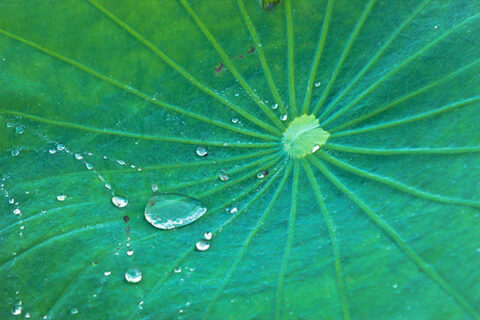Lotus effect for organic liquids

Researchers improve self-cleaning properties of ceramic materials
Materials scientists at FAU have developed a process that allows self-cleaning properties to be applied to ceramic surfaces that also work for organic liquids such as oils and alcohol. Their findings have recently been published in the renowned Journal of Materials Chemistry A in a special issue on the work of young researchers (doi: 10.1039/C5TA08992A).
We are all familiar with the Lotus effect where liquid drips off a surface without making it wet. The leaves of the lotus flower after which it is named and other hydrophobic plants have a structure formed of microscopic papillae that reduces the contact surface significantly and forces liquids to form droplets. For over twenty years, it has been possible to mimic this self-cleaning effect, which has technical applications in tiles, glass surfaces and façade paint, for example.
‚Unfortunately this effect only works well for water because water has a very high surface tension and therefore has the tendency to form drops,‘ says Prof. Dr. Nicolas Vogel from FAU’s Chair of Particle Technology. ‚This characteristic is less pronounced in other liquids, particularly organic oils and alcohol.‘ Professor Vogel has spent years researching how ceramic surfaces can be manipulated to allow the wetting behaviour of liquids with low surface tensions to be controlled.
Tiny pores in glass
Process engineers at FAU have now come a step closer to achieving this goal, as Professor Vogel and his colleagues have succeeded in inserting minute polymer nanoparticles with a diameter of under 1µm into the surface of glass while controlling how deeply they are embedded. The tiny particles are then removed through calcination. This creates minute pores in the substrate with an opening angle of less than 90 degrees. ‚The most important aspect of this process is that we are able to control how far the colloids are embedded and therefore the opening angle of the pores very precisely,‘ Prof. Vogel explains.
Applications in hygiene
The FAU researchers‘ findings lay the foundations for developing materials that repel not only water but also organic liquids. Such self-cleaning properties could have a positive effect on hygiene in areas of medicine where it is important that materials do not absorb bodily fluids. They could also be useful in glass surfaces such as glass cabinets, doors and camera lenses that need to be protected from oils and fats. ‚Our process currently only works under laboratory conditions,‘ Nicolas Vogel says. ‚However, in principle it is scalable, so it should be possible to adapt it for the industrial scale.‘
A fascinating glimpse of the microscopic world
You can find out more about how materials scientists take inspiration from sea shells, butterfly wings or indeed the lotus flower in an exhibition that is currently on display at the Botanical Garden in Erlangen. Near the entrance you will find spectacular microscopic images of different surfaces from the animal kingdom and the plant world. The poster exhibition ‚Kleine Strukturen – große Wirkung‘ (small structures – big effects) was organised by the Cluster of Excellence ‚Engineering of Advanced Materials‘ (EAM), which is also part of Nicolas Vogel’s research group. The exhibition will run until 28 August 2016 and is open from Tuesday to Sunday between 9.30 a.m. and 3.30 p.m. Entry is free of charge.
Further information:
Prof. Dr. Nicolas Vogel
Phone: +49 9131 8520357
nicolas.vogel@fau.de